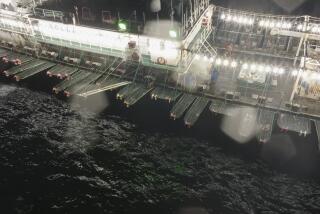First Woman Captain : Managing a Ship Is an ‘8-to-5 Desk Job’
- Share via
Should anyone imagine today’s ship captains as swashbuckling figures commanding rowdy crews amid adventure on the high seas, let Lynn Korwatch set them straight. Not only are they not swashbucklers--not all of them are male anymore.
“What captains have become over the years are administrators,” said Korwatch, who is believed to be the first woman to command a large U.S. commercial vessel. “You are sitting at a desk all day long. There’s a lot of paper work to be done. It’s not like Clark Gable as Fletcher Christian. It’s very professional. We don’t Shanghai anybody. It’s not like that anymore.”
Korwatch’s sober view of the role of the modern-day ship commander comes after a two-week stint as captain of a container ship. The 35-year-old San Francisco native acted as relief captain for the container ship Maui, owned by Matson Navigation, when the craft sailed from Oakland on June 1 on a round-trip voyage to Honolulu.
Don’t Want It Sunk
Korwatch, whose permanent job is chief mate on another Matson Navigation ship, was one of the first woman graduates from the California Maritime Academy in Vallejo and is one of several women who have earned licenses from the U.S. Coast Guard authorizing them to captain large ships.
A woman in Texas recently became captain of a training ship for the Texas Maritime Academy. But officials at Matson Navigation, the U.S. Merchant Marine Academy and the U.S. Maritime Administration cannot recall a woman actually taking command of a large commercial ship before Korwatch sailed the Maui out under the Golden Gate Bridge.
“There are not that many women sailing,” said R. J. Murray, general manager of marine operations at Matson Navigation in San Francisco. But, “you look at the makeup of any class in maritime school today, and you will see more women.”
“She’s done her time in the trenches,” Murray said of Korwatch’s 12 years of experience aboard commercial ships. “She did very well.”
Korwatch’s interest in a seagoing life was triggered after reading an newspaper article about the California Maritime Academy, which was taking applications from women for the first time. “I knew virtually nothing about ships,” said Korwatch, who was working as a saleswoman in a dress shop. She applied, was accepted and graduated in 1976.
She has since worked on board Matson tankers and container ships and was promoted to chief mate--second in command--in 1984. In March, Matson told her that she would be relief captain of the Maui. “I was really excited,” Korwatch said. “There is a lot of money riding on you. They don’t want anybody who is going to sink it.”
Her role as captain took a while to get used to, Korwatch says. “Suddenly people who always addressed me as ‘Lynn’ addressed me as ‘Captain.’ You look around and say, ‘Who are they talking to?’ ”
Korwatch said the uneventful two-week round trip was fairly typical of the voyages made by the container ships that ply the Pacific between the West Coast and Hawaii. The Maui was carrying containers filled with everything from fresh vegetables to beach chairs. “Half the time we don’t know what’s on board--only when its hazardous,” Korwatch said.
Unlike her 12-hour work days as chief mate, Korwatch said she worked pretty much an 8-to-5 shift as captain, with much of her days spent at her desk. “You have to do payroll, and Coast Guard forms have to be filled out,” she said. “It’s a whole different kind of job.”
35-Person Crew
Korwatch compared her job to those held by any top manager: “You have got a multimillion-dollar operation going out there. You have to learn to trust your people who are working with you.”
Korwatch said her crew of 35, which included three women, had no trouble taking orders from a female captain. “I’m not walking in out of the cold. I’ve worked my way through the company. They know me.”
For the crew’s recreation, the Maui has a library stocked with videocassettes and books. “We do a lot of reading. Nothing notable--you are reading just as a time waster,” the captain said. Does it ever get boring? “Well, kind of.”
The tricky portion of any ocean voyage is the approach to port, she said. The ship has to maneuver around pleasure craft, piers and other obstacles.
“It takes a ship three miles to come from a full sea speed to a stop,” Korwatch said. “You have to figure out what to do way in advance, in case of an emergency. We don’t have brakes.”
Despite sometimes being at sea for three months at a time, Korwatch says she loves her job. “I like going to sea. I don’t like to commute. You get on the bridge every morning and fight traffic. You put on your dress-for-success outfit. You get into your little office from 9 to 5.” It was not the life for her.
Korwatch, who is scheduled to captain a ship once more in December, works a three-months-on, three-months-off schedule. She said she relishes the three-month vacations, which she spends with her husband, Lawrence, a seagoing chief engineer with Matson Navigation. He works the same schedule, but on different ships. The couple is expecting their first child next month.
More to Read
Sign up for The Wild
We’ll help you find the best places to hike, bike and run, as well as the perfect silent spots for meditation and yoga.
You may occasionally receive promotional content from the Los Angeles Times.






